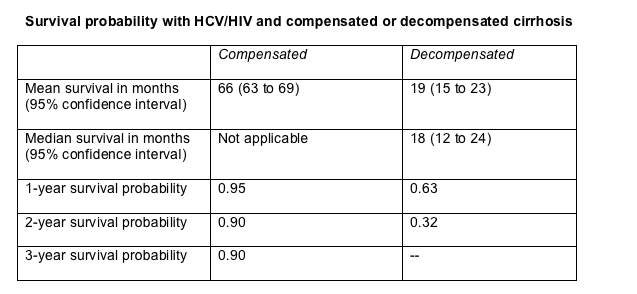 |
 |
 |
| |
High Death Risk With HIV, HCV, and Decompensated Cirrhosis
|
| |
| |
11th European AIDS Conference
October 24-27, 2007
Madrid
Mark Mascolini
Decompensated cirrhosis--marked by gastrointestinal bleeding, ascites, or hepatic encephalopathy--is a grim harbinger for people coinfected with hepatitis C virus (HCV) and HIV, according to results of a 373-person prospective cohort study by Spanish clinicians [1]. Although per-year probability of decompensation proved low in this cohort, once it occurred 3-year mortality was high.
Maria Lopez-Dieguez and colleagues from eight Spanish centers undertook the study because cohort data on the natural history of HIV and HCV in people with compensated versus decompensated cirrhosis remains scant. They included HIV/HCV-coinfected people with biopsy-documented cirrhosis or advanced bridging necrosis, decompensation, or a Bonacini score at or above 8 [2].
The comparison involved 275 people with compensated cirrhosis and 98 with decompensated cirrhosis. Study participants were infected with HIV for a median of 15 years and with HCV for a median of 23 years; 22% were women. Similar proportions in the compensated and decompensated groups got infected with HIV by injecting drugs (87% and 91%), and similar proportions were taking antiretrovirals (89% and 80%). Both baseline and nadir CD4 counts were lower among people with decompensation (239 and 104) than in those with compensated cirrhosis (434 and 175). A lower proportion with decompensated cirrhosis than with compensated cirrhosis had an undetectable HIV load (65% versus 76%).
After a median 18 months of monitoring, 19 people in the decompensated group (19.4%) and 21 in the compensated group (7.6%) had dropped out of the study group. While 43 people with decompensated cirrhosis (54.4%) reached a primary endpoint (death, hepatocellular carcinoma, or liver transplantation), only 17 (6.7%) in the compensated group reached one of those endpoints. Among 38 people who died in the decompensated group, 27 (71%) died of liver disease; of 17 people who died in the compensated group, 6 (35%) died of liver disease.
Survival, defined as time from cohort entry until death, liver cancer, or liver transplantation, measured 92% in the compensated group after 18 months of follow-up and 53% in the decompensated group, a highly significant difference (P < 0.0001). One-year probability of survival measured only 63% in people with decompensated cirrhosis, and 2-year probability only 32% (Table).

Survival at 18 months tracked closely with Child-Pugh score--96% with Child-Pugh A, 53% with Child-Pugh B, and 27% with Child-Pugh C (P < 0.0001). One-year probability of survival stood at 98% with Child-Pugh A, 65% with B, and 32% with C. Lopez-Dieguez suggested those results mean Child-Pugh scores are a reliable prognostic marker in people coinfected with HCV and HIV.
The only good news from this study came in the low yearly risk of decompensation. Probability of first decompensation measured only 4% in 1-year of follow-up, 7% in 2 years, and 9% in 3 years.
Lopez-Dieguez maintained these findings underline the critical importance of avoiding decompensation in people coinfected with HCV and HIV.
References
1. Lopez-Dieguez M, Pascual JF, Montes M, et al. Morbidity and mortality in HIV infected patients with compensated and decompensated cirrhosis: prospective cohort of 373 patients. European AIDS Conference. October 24-27, 2007. Madrid. Abstract P8/2.
2. Bonacini M, Hadi G, Govindarajan S, Lindsay KL. Utility of a discriminant score for diagnosing advanced fibrosis or cirrhosis in patients with chronic hepatitis C virus infection. Am J Gastroenterol. 1997;92:1302-1304.
|
| |
|
 |
 |
|
|